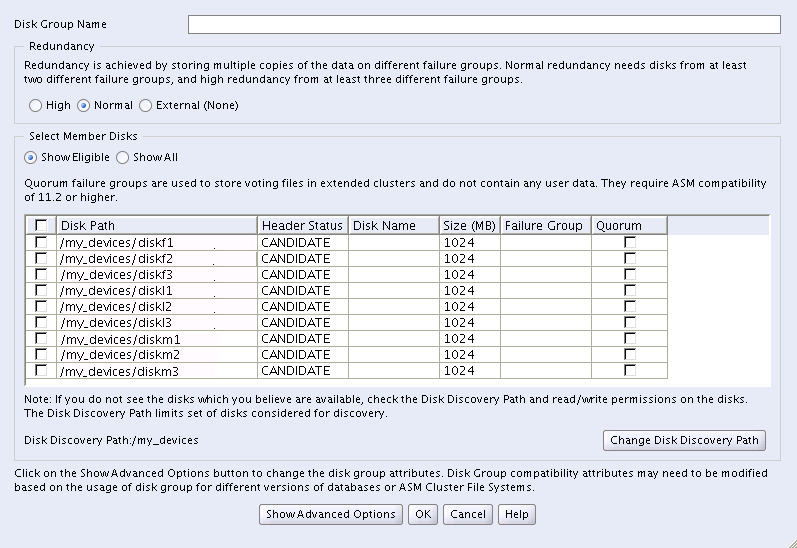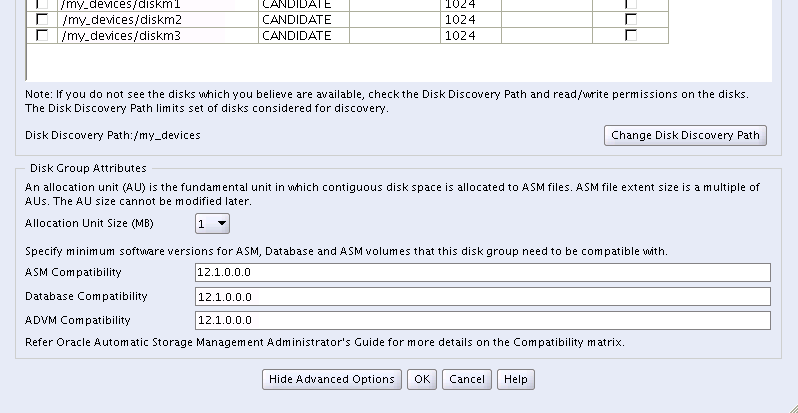Managing Disk Groups with ASMCA
Oracle ASM Configuration Assistant enables you to configure or create Oracle ASM disk groups with the Configure ASM Disk Groups tab, as shown in Figure 9-4. The disk group tab displays selected details about the disk group, such as name, size, free space, usable space, redundancy level, and state of the disk group.
Oracle Database Reference for descriptions of disk group information displayed in the V$ASM_DISKGROUP view
You can right click a selected disk group in the screen to display the configuration options menu. The menu options enable you to:
-
Add disks to and drop disks from the disk group
-
Edit the disk group attributes
-
Manage templates for the disk group
-
Create an Oracle ACFS file system on the disk group for database use
-
Mount and dismount the disk group
-
Drop the disk group
Figure 9-4 Oracle ASM Configuration Assistant Configure Disk Groups Page

Description of "Figure 9-4 Oracle ASM Configuration Assistant Configure Disk Groups Page"
There are additional options for creating a disk group, mounting all disk groups, and dismounting all disk groups.
Oracle ASM Configuration Assistant enables you to create an Oracle ASM disk group by clicking Create on the Oracle ASM Configuration Assistant disk group page. The page for creating a disk group is shown in Figure 9-5.
Figure 9-5 Oracle ASM Configuration Assistant Create Disk Groups Page

Description of "Figure 9-5 Oracle ASM Configuration Assistant Create Disk Groups Page"
On this page, you can enter a name for the disk group, select the redundancy level, change the disk discovery path to locate disks in a different directory, identify the disks to be in the disk group, enter a name for a failure group, and specify if the failure group is a quorum type.
A quorum failure group is a special type of failure group and disks in these failure groups do not contain user data and a quorum failure group is not considered when determining redundancy requirements with respect to user storage. However, a quorum failure group counts when mounting a disk group. For information about quorum failure groups, see "Storing Oracle Cluster Registry and Voting Files in Oracle ASM Disk Groups".
If Oracle ASM Filter Driver has been configured for your system, you can add Oracle ASM Filter Driver labels to disks or clear Oracle ASM Filter Driver labels from disks. For information about Oracle ASM Filter Driver, refer to "Oracle ASM Filter Driver".
You can choose to show advanced options when creating a disk group, as shown in Figure 9-6. The advanced options section enables you to set additional options, such as disk group compatibility settings and allocation unit (AU) size. When you are finished with the create disk group specifications, click OK.
For Oracle ASM 12c, the default disk group compatibility settings are 12.1 for Oracle ASM compatibility, 10.1 for database compatibility, and no value for Oracle ADVM compatibility. For information about disk group compatibility attributes, see "Disk Group Compatibility". For information about disk discovery, see "Oracle ASM Disk Discovery " and "ASM_DISKSTRING".
The disk group compatibility settings can only be advanced. You cannot revert to a lower compatibility setting after you advance the disk group compatibility settings. See "Overview of Disk Group Compatibility"
Figure 9-6 Oracle ASM Configuration Assistant Create Disk Groups - Advanced Options

Description of "Figure 9-6 Oracle ASM Configuration Assistant Create Disk Groups - Advanced Options"
For more information about managing disk groups, see Administering Oracle ASM Disk Groups.